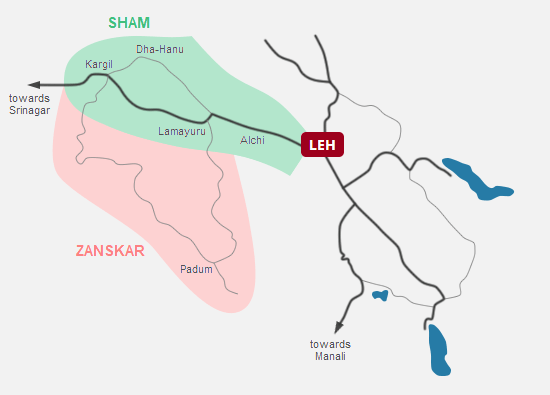

The Zanskar valley is a hidden gem for travellers seeking an authentic village life experience in the remote Himalayan region. It is also home to numerous monasteries steeped in history, with the most renowned being the enchanting Phuktal monastery.
The Zanskar valley is accessed from Leh and the Indus valley via Singe La pass at an altitude of 5,360 metres above sea level. After descending from the pass, you will arrive at Lingshed, a charming Zanskari village with a prominent whitewashed gompa.
The town of Padum, the capital of Zanskar, serves as an ideal base for exploring the nearby villages, palaces, and monasteries of the region, including Zangla, Stongde, Karsha, Bardan, Sani and Zongkhul.
As you drive from Padum towards Rangdum, you will encounter a variety of natural wonders, such as Pensi La & Drang Drung glacier, Parkachik glacier & Nun Kun Peak and the breathtaking Suru valley.
As part of your Zanskar tour, you will have the chance to explore all the attractions situated between Leh and Kargil in the Sham region of Ladakh. This includes visits to the well-known monasteries in the Indus valley, such as Alchi, Likir, Lamayuru, Shargole, Rizong, Basgo, Phyang and Spituk.
Other nice places that you will be able to see during this tour include the 8-metre-high Maitreya Buddha rock carving at Mulbek, the confluence of Indus and Zanskar rivers known as Sangam, the mysterious Magnetic Hill and the Sikh place of worship Gurdwara Pathar Sahib.
You can choose the duration of your Zanskar tour. It is advisable to plan for a minimum of 5 days.
At the end of the tour, from Kargil, you could go to Srinagar instead of coming back to Leh.
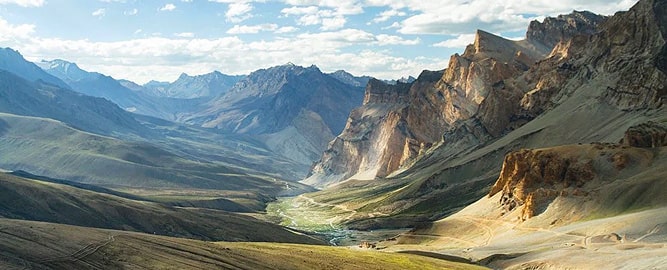
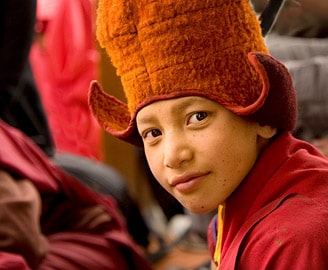
The remote and secluded Zanskar valley is renowned for its breathtaking landscapes and authentic, untouched villages that seem to exist outside of time. Within this picturesque valley, history-rich monasteries often take root around ancient cliff-top meditation caves, safeguarding an ancient form of Buddhism for posterity.
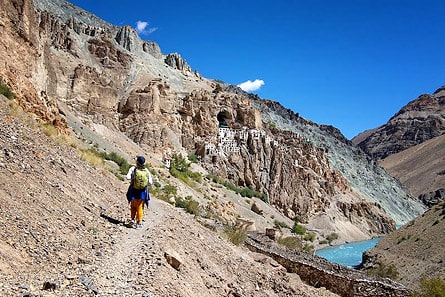
Phuktal monastery, situated in the southeastern part of the Zanskar region in Ladakh, is the most impressive attraction in the area and one of the most secluded gompas. It is constructed around a natural cave, a sacred site believed to have drawn scholars, translators, and monks over 2,550 years ago. Its remote location made it an ideal haven for monks seeking tranquility for meditation. The present-day Phuktal monastery follows the Gelug school of Tibetan Buddhism and was founded in the early 15th century by Jangsem Sherap Zangpo, a disciple of Je Tsongkhapa.
The name 'Phuktal' derives from the Zanskari dialect, where 'Phuk' means 'cave,' and 'tal' means 'at leisure'. Reaching this monastery involves a two-hour walk, making it an ideal adventure for hiking enthusiasts who want to experience the natural beauty along the Tsarap river.
Within the monastery, you will discover four prayer rooms, a library and a kitchen. The gompa serves as the residence for approximately 70 monks. Moreover, there is a monastery guesthouse where travellers can spend the night.
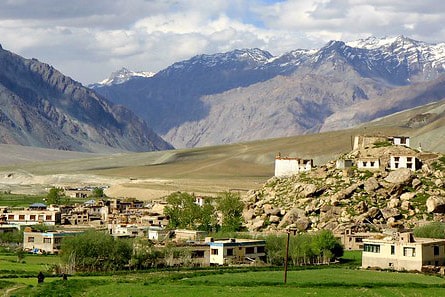
Padum, situated at an altitude of 3,669 meters, serves as the capital of the Zanskar region and is home to approximately 1,500 residents. This charming town provides a variety of amenities, including quaint restaurants, hotels, guesthouses, and shops. It offers easy access to nearby villages and monasteries, making it an ideal central hub for travelers seeking to explore the Zanskar region.
The historical center of the village is situated beneath the gompa and the ruins of the Palace khar, with two prominent chortens overlooking the old buildings. The population of Padum is approximately 60% Buddhists and 40% Muslims, reflecting the diverse cultural tapestry of the region.
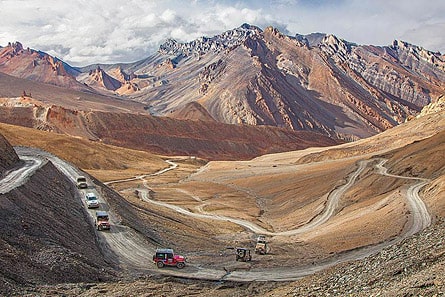
Singe La (also spelled Singge La) is a mountain pass that links the Leh region to Zanskar, sitting at an impressive altitude of 5,057 meters. This route is usually open for travel from late May to mid-October but becomes impassable during the harsh winter months when heavy snow blankets the landscape. Singe La is situated approximately 180 kilometers from Leh and 100 kilometers from Padum.
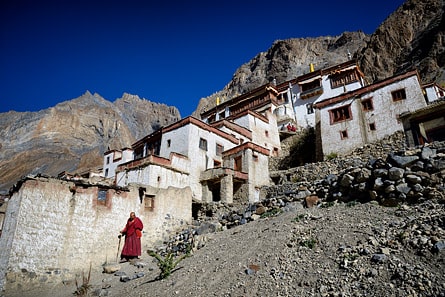
Lingshed monastery is an historical and spiritual treasure nestled amidst the majestic Zanskar Range mountains on the south side of Singe La pass. Founded in the 1440s by Changsems Sherabs Zangpo, a disciple of Je Tsongkhapa, it is located 83 kilometers north of Padum. This Gelugpa Buddhist monastery has a rich history, originally established on a monastic site founded by Translator Rinchen Zangpo.
Today, Lingshed monastery houses around 60 monks and serves as a spiritual center for neighboring villages. The complex includes six principal shrines, kitchens, storage rooms, and accommodations for visiting high lamas. Beyond the central temple, monastic quarters fan out, and outlying shrines are maintained in nearby villages. Lingshed monastery not only offers a window into Tibetan Buddhism but also connects visitors to centuries of devotion in this remote Himalayan region, making it a truly special place to explore.
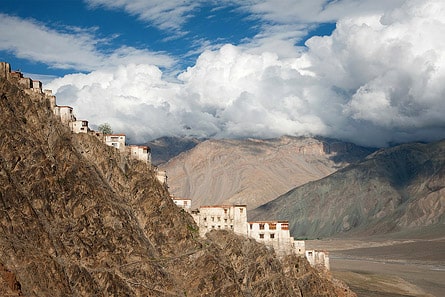
Karsha monastery stands as the largest and most significant monastery in the Zanskar valley. Affiliated with the Gelugpa or Yellow Hat sect, this monastery comprises a series of 30 whitewashed buildings, cascading along the mountainside.
Presently under the guidance of the younger brother of the 14th Dalai Lama, Karsha monastery was established by the Buddhist master Phagspa Sherab, who introduced Buddhism to the Zanskar valley and is attributed to Guru Padmasambhava. Within the monastery, you can find numerous shrines, ancient rock carvings and the Avalokiteshvara Temple. However, the most remarkable feature of the monastery is a chorten that houses the mummified remains of Rinchen Zangpo, an incarnate lama, enclosed within a wooden box adorned with silver.
Karsha Monastery, serving as the residence for 120 monks, has a unique tradition of conch blowing during lunch and dinner to gather the monks for meals. Like many monastic festivals in Ladakh, resident monks perform masked cham dances during Karsha's monastery festival, which takes place on the 6th and 7th days of the 6th Tibetan month and is known as Karsha Gustor.
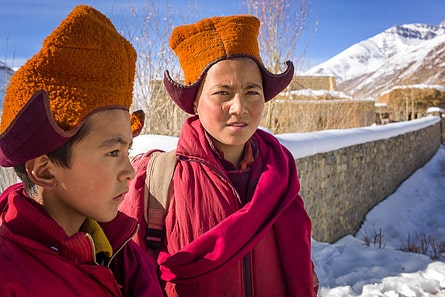
Zangla village, once ruled by a monarch who still resides here with his family, is a unique and historic place. An old palace on a nearby hillock, just a 15-minute hike away, overlooks the village. Inside the palace, an intact Buddhist shrine offers breathtaking views of the valley.
Another intriguing spot in Zangla is the nunnery center, where travelers can gain insights into the daily lives of the nuns. Explore this charming village to experience its royal heritage and spiritual culture.
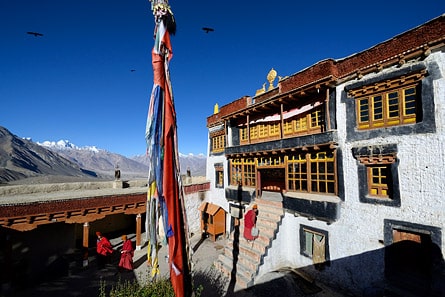
Stongde monastery, one of the most significant gompas in Zanskar, may not appear very imposing when viewed from below, but it occupies a prominent vantage point that offers breathtaking views of the Zanskar valley, especially in the morning light.
Legend has it that Stongde was once situated on the shores of a large lake. A small, box-like room below the main monastery, which is believed to have been right at the lakeside about a thousand years ago, is said to have been used by the Tibetan Buddhist Great Translator Marpa Lotsawa for meditation.
While the current monastery structure mainly dates back to the 20th century, a small and atmospheric prayer room on the left side as you enter the inner courtyard houses ancient murals that are believed to be over 250 years old.
The monastery's festival takes place on the last day of the fifth month and the first day of the sixth month in the Tibetan calendar.
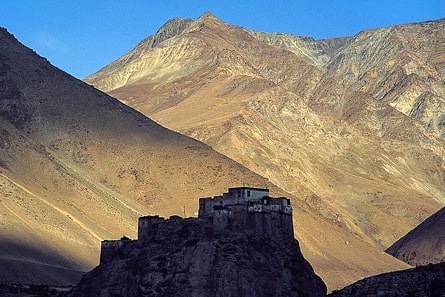
Bardan monastery is a 17th-century Buddhist gompa, approximately 12 kilometers south of Padum, situated on the banks of the Lungnak river. This charming monastery boasts a grand Dukhang, an assembly hall adorned with magnificent statues of revered Buddhist deities and a collection of small stupas.
Perched atop a rocky outcrop, Bardan monastery resembles a fortress, exuding an aura of spiritual tranquility. According to legend, this monastery was originally constructed atop a mountain named Thar Lha. However, a remarkable event occurred when a crow carried a butter lamp and placed it on a rocky spur. Bodhisattva Dewa Gyatso interpreted this as a favorable omen and decided to build the current Bardan monastery on this very rock. The remnants of the original monastery and a chorten can still be spotted at the summit of Thar Lha mountain, adding an intriguing historical layer to Bardan monastery's rich heritage.
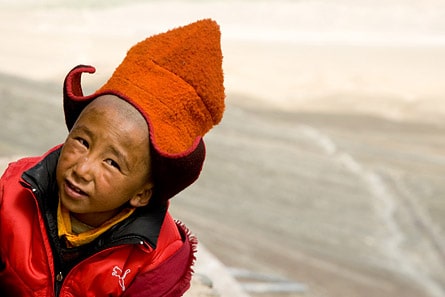
Sani monastery, located on a flat area much like Alchi, belongs to the Drukpa school and is affiliated with Stakna in Ladakh. This school holds a special reverence for the master Naropa, and a small chapel within is said to house relics of this great teacher. Sani monastery is a captivating blend of diverse elements spanning different eras and architectural styles.
Situated in the heart of the village, Sani monastery stands as one of the oldest monastic institutions of Tibetan Buddhism in Ladakh and Zanskar. The gompa boasts a quaint two-storey prayer hall encircled by a curious tunnelled cloister. Its historical significance is further highlighted by a 6-meter-high Kanika Chorten stupa at the rear, dating back to the time of Kushan King Kanishka in the 2nd century AD, making it the oldest Buddhist monument in the Zanskar region.
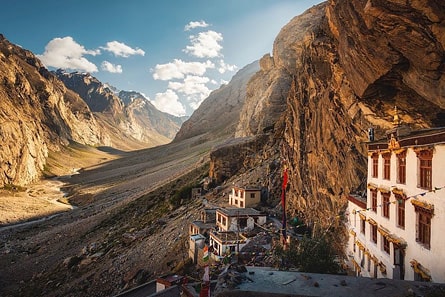
Zongkhul monastery stands upon a rocky façade that houses two caves. Legend has it that the renowned Indian scholar-saint, Naropa, engaged in a two-year meditation retreat within the lower cave. A rock near the entrance bears his footprint as evidence. Additionally, the cave walls feature exquisite frescoes, attributed to Zhadpa Dorje, an artist who visited the monastery approximately three centuries ago.
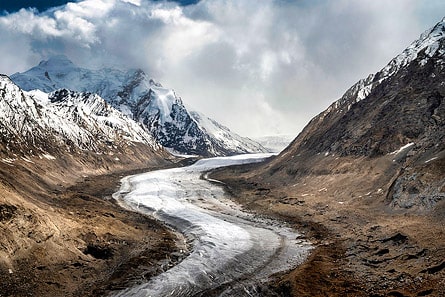
Pensi La, located 150 km south of Kargil, is a mountain pass at an elevation of 4,400 meters above sea level. This pass connects the Suru valley and the Zanskar valley regions.
From the pass, you can enjoy a stunning view of the Drang Drung glacier. This glacier is one of the largest in Ladakh, measuring 23 kilometres in length and averaging an elevation of 4,750 meters.
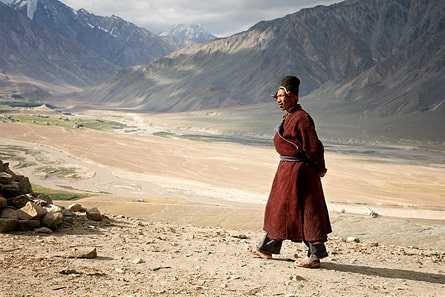
Rangdum, situated at the end of the Suru Valley, is the first Buddhist village along the route to Zanskar. The monastery, perched on a small hill, is affiliated with the Gelugpa order.
Historical records indicate that Gelek Yashy Takpa constructed this monastery during the reign of King Tsewang Namgyal II of Ladakh in the 18th century. Despite its geographic location in the Suru Valley, it is culturally part of Zanskar.
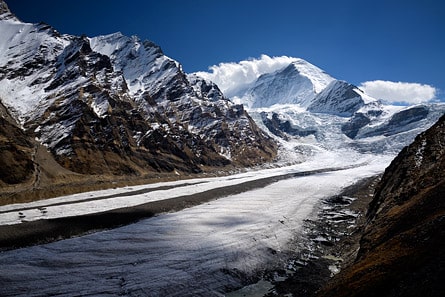
Parkachik glacier, situated on the slopes of Nun Kun peak, showcases its expansive icy terrain. This glacier is a prominent natural attraction.
Nun Kun Peak, featuring two imposing mountain summits, is a significant geographical landmark in the region. With an elevation of 7,135m and 7,087m, this peak dominates the landscape and provides an alluring challenge for mountaineers.
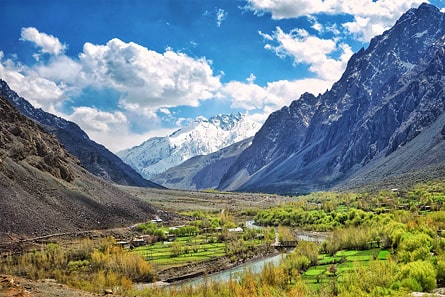
Situated to the south of Kargil, the Suru valley is a fertile and picturesque region embraced by the Suru river, a tributary of the Indus river. This charming valley not only sustains the local communities but also boasts awe-inspiring landscapes.
The population of Suru valley, which comprises approximately 25,000 people, is predominantly adherent to Shia Islam. A minority within the community follows the Sunni branch of Islam, with a larger concentration in the villages of Panikhar and Prantee.
The Zanskar valley tour is feasible from mid-May to mid-October, when the Singe La pass is open to traffic. Throughout the rest of the year, the road is inaccessible. The responsibility for road maintenance and snow clearance falls under the purview of the Border Roads Organisation (BRO), a division of the Indian Ministry of Defence.
During the winter months, when the road to the Zanskar valley remains closed, adventurous travellers have the unique opportunity to access the valley via the renowned Chadar trek. This remarkable journey spans eight days, leading intrepid trekkers across the frozen Zanskar river, which connects Chilling (located near Leh) to Lingshed.
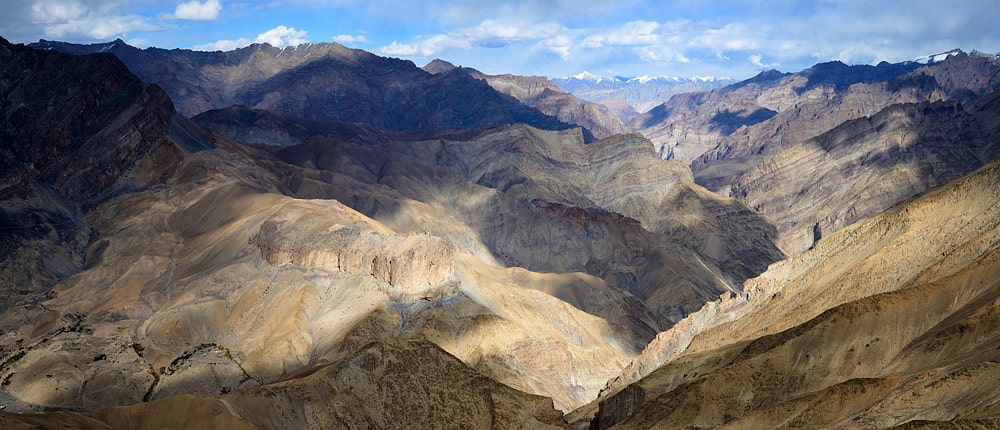
Zanskar valley is at an average altitude of around 3,800 meters, with most of its villages, including Lingshed, Karsha, Padum, and Phuktal, situated below 4,000 meters. However, to access this region, you must cross the Singe La pass, which reaches an altitude of 5,057 meters. Even though your time at this high altitude is brief, it is important to respect a proper acclimatization. We recommend spending 2 days acclimatizing in Leh or the Indus valley before crossing the pass into Zanskar.
You do not need an Inner Line Permit to travel to Zanskar. However, you will still need to contribute to the Ecology Contribution Fund.
Phone and internet service in Zanskar is quite limited, with reliable connectivity primarily found in Padum, the main town of the region. Beyond Padum, expect sparse or no mobile and internet signals throughout most of the area. It's advisable to handle necessary calls and messages in Padum before venturing further into Zanskar, as connectivity becomes increasingly scarce.
In Zanskar, the primary hub for hotels is Padum, the main town of the region. Beyond Padum, accommodations shift towards small guesthouses and homestays, making them the prevalent lodging options.
In the Zanskar valley, homestays are readily available in every village, offering an authentic and cost-effective lodging experience. Upon your arrival, your driver will guide you to the most suitable and recommended homestay options, ensuring a memorable and immersive stay in the valley.
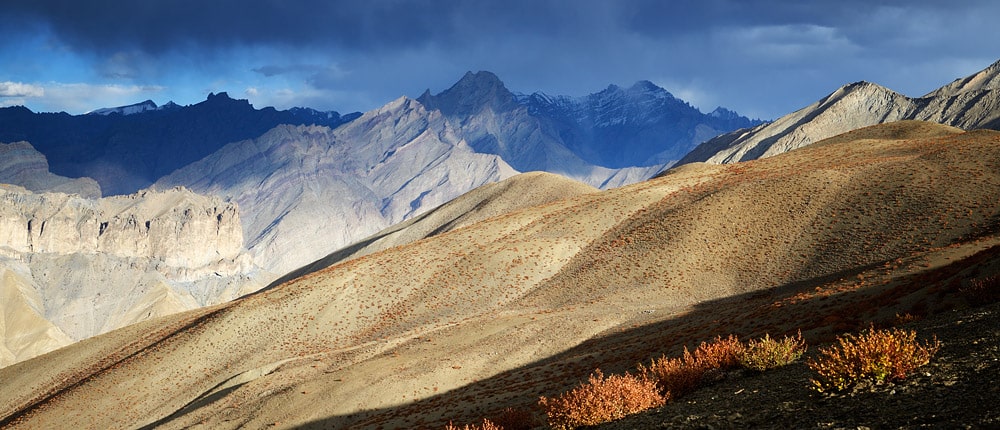
Start your journey from Leh by heading west along the Indus valley. Along the way, visit Phyang monastery, marvel at the Magnetic Hill's gravity-defying wonder, stop for photos at Sangam (confluence of the Indus and Zanskar rivers), explore the historic site of Basgo and admire the ancient murals at Alchi monastery. Night in Alchi.
Embark on a scenic drive from Alchi to Lingshed via Singe La pass, which stands at an elevation of 5,057 meters, offering awe-inspiring mountain vistas. En route to the pass, you will pass through the charming village of Photoksar, and on the other side of the pass, you will find yourself entering the breathtaking Zanskar region, with Lingshed as your destination. Explore Lingshed monastery and soak in the serene beauty of this remote Zanskari village. Night in Lingshed.
Drive from Lingshed to Padum, passing through the charming villages of Zangla and Stongde. In Zangla, explore the palace and the monastery. In Stongde, visit the second-largest monastery in Zanskar, offering breathtaking panoramic views of the valley. Night in Padum, the capital of the Zanskar region.
Begin your day by visiting Karsha monastery, the largest gompa in Zanskar, a spiritual gem in the region. Then, drive south towards the starting point of the Phuktal trail, with a stop at Bardan monastery, perched atop a rocky hill, en route. Embark on a 2-hour hike to reach the awe-inspiring Phuktal monastery, ingeniously nestled within a cliffside cave. This remarkable site not only showcases architectural marvel but also serves as a hub for Buddhist learning and meditation. Night in Phuktal monastery guesthouse.
Begin your day by immersing yourself in the tranquil atmosphere of Phuktal monastery. Explore the gompa, attend morning prayers, observe monks in their daily routines and enjoy the beauty of the Lungnak river valley. Then, return to Padum for the night.
Drive from Padum to Rangdum, with stops at the ancient Sani and Zongkhul monasteries. Sani monastery boasts an ancient stupa dating back to 127 CE, while Zongkhul monastery, perched on a rugged rock face, is known for its historic meditation cave adorned with 300-year-old frescoes by Zhadpa Dorje. Cross the scenic Pensi La pass for panoramic views of the Drang Drung glacier. Explore the unique architecture and spiritual ambiance of Rangdum monastery upon arrival. Night in Rangdum.
Begin your day by catching sight of the Parkachik glacier and the towering Nun Kun peak, which stands impressively at an altitude of 7,135m. Travel through the picturesque Suru valley until you reach Kargil, the second-largest town in Ladakh. While heading towards Lamayuru, you will have the opportunity to visit the unique Shargole monastery, renowned for its troglodyte architecture, and explore the ancient rock carvings of Mulbek. Night in Lamayuru.
Conclude this 8-day tour with a morning visit to Lamayuru gompa, where you can join the monks for their morning prayers. Afterward, head back to Leh, with stops along the way to visit Rizong and Likir monasteries, the Sikh temple Gurdwara Pathar Sahib and Spituk monastery.
